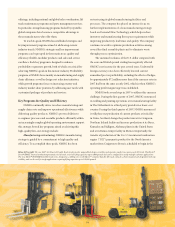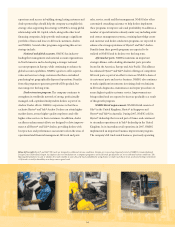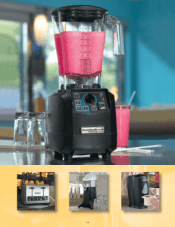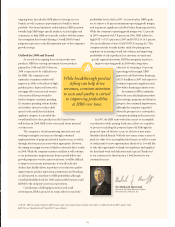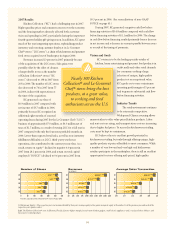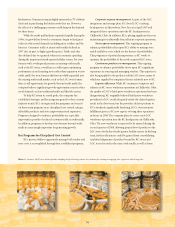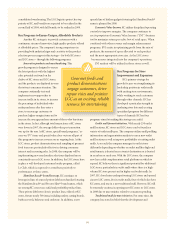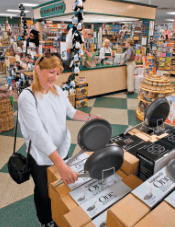Hamilton Beach 2007 Annual Report Download - page 26
Download and view the complete annual report
Please find page 26 of the 2007 Hamilton Beach annual report below. You can navigate through the pages in the report by either clicking on the pages listed below, or by using the keyword search tool below to find specific information within the annual report.
commercial appliances sold under strong brand names and to
achieve profitable growth from innovative solutions that
improve everyday living. HBB’s financial objective is to achieve
a minimum operating profit margin of 10 percent and to
generate substantial cash flow before financing activities.
Industry Trends
Competition in the housewares industry continues to be
intense. Rising costs of transportation and raw materials such
as plastic, copper, aluminum and steel continue to place
significant pressure on margins. To lower costs further and
provide greater value, HBB and other housewares suppliers
have transferred most, if not all, of their manufacturing to
third-party manufacturers located in lower-cost regions,
primarily Asia. Therefore, further dramatic cost reductions are
increasingly difficult to achieve as the outsourcing process is
completed and material and transportation costs rise.
As housewares products face heightened competition for
consumers’ disposable income, new, innovative products
become even more important to driving growth and higher
margins. Several consumer trends are favorable for small
kitchen appliances, including the growing popularity of both
gourmet and on-the-run home cooking. Brands also continue
to be important in this market. However, because barriers to
entry are low, HBB can face challenging competition from new
products with new brand names. Overall, the market growth
rate in small kitchen appliances is likely to be slightly negative
to very low due to economic uncertainties, including a
significantly weakened housing market in the United States.
Strong relationships with the leading retailers are critical
for success. Leading retailers for small kitchen appliances
include mass merchants, warehouse clubs, specialty stores and
Internet sites. Shelf placement is highly competitive and sales
are increasingly driven by promotional activity in the fourth-
quarter holiday season, which delivers a significant portion of
annual sales. The impact of winning or losing a single product
placement or multi-product placement program at specific
retailers is being magnified as certain retailers’ shares of the
overall market grow. Other retailer trends include the increased
offering of private-label versions of small kitchen appliances, as
well as a growing interest in products, packaging and processes
considered to be environmentally sustainable.
To achieve its stated goals, HBB has established strategies
and key programs aimed at responding to these industry trends.
These strategies and programs focus on three fundamental
areas: continuous cost reduction; innovation; and professional
sales and marketing. Each key program is designed to enhance
profitability or generate growth. Profit enhancement programs
focus on efficiencies in product development, purchasing and
the supply chain, while growth programs focus on new
innovative products, branding and distribution channel
optimization. HBB believes these strategies and programs, in
combination with the company’s core competencies, will help
HBB remain competitive in a challenging industry and position
the company for even greater future success.
Key Programs for Continuous Cost Reduction
HBB is focused on driving continuous cost reduction
throughout the entire company and at all of its suppliers. The
goal to achieve a 10 percent operating profit margin has become
part of the company’s culture. The company’s exceptional ability
to identify and eliminate unnecessary costs across the value
chain is a key competitive advantage. Key programs directed at
accomplishing improvements and cost reductions include:
Purchasing and supplier product cost reduction. A shift to
outsourced manufacturing for all consumer and commercial
Below left to right: Proctor Silex® Easy Slice™ electric knife, Hamilton Beach® 3-in-One slow cooker, Hamilton Beach® Commercial drink mixer.
[22]



